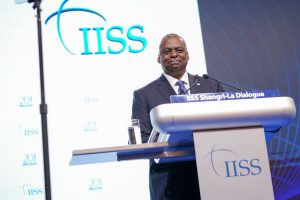“The only thing more wide-ranging than the conference agenda is the breakfast buffet,” declared Lloyd Austin in his address to the Asian defense summit known as the Shangri-La Dialogue.
The U.S. defense secretary’s nod to culinary diversity at the event in June drew appreciative murmurs from the audience. The multi-cuisine cooking stations at the conference venue are a point of pride in food-centric Singapore.
Austin is a frequent visitor to Singapore and other Association of Southeast Asian Nations (ASEAN) member states. “I’ve come to Southeast Asia to deepen America’s bonds with the allies and partners on whom our common security depends,” he explained on one of his early visits. The American military delegation invariably shows up in full force, notes James Crabtree, who runs the Shangri-La Dialogue for the International Institute for Strategic Studies. “The U.S. Defense Secretary will come with between 150 and 200 people on the plane, including a whole bunch of journalists,” said Crabtree in an interview with the Sinica podcast.
The United States military has surprising reserves of goodwill in Southeast Asia despite a checkered history dating back to the Vietnam War. A new report on the region described the Pentagon’s engagement as “America’s strongest and best asset.” David Shambaugh, director of the China Policy Program at George Washington University, who co-authored the Asia Society policy paper, pointed out that eight of ten ASEAN nations had extensive military ties with Washington. Laos and Myanmar were the outliers.
Security partnerships with the U.S. are part of a “hedging strategy” in Southeast Asia to maintain the balance of power in the region, explained Shambaugh. But he added that ASEAN governments “don’t want to advertise” their defense ties, which include joint military exercises, arms sales, and networking at events like the Shangri-La Dialogue. A recent Lowy Institute poll found that “Washington’s defense networks continue to far outstrip those of Beijing.”
But neither the U.S. nor China have come close to matching Moscow on arms sales. Until recently, Russia was the leading supplier of low-cost weapons to ASEAN. However, the Ukraine war upended that equation, and the region no longer views Moscow as a reliable source of military hardware. In September, Vietnam elevated the U.S. to the top tier of its bilateral relationship hierarchy in a “historic upgrade.” The new “comprehensive strategic partnership” will include a security component which could lead to future arms deals.
Evan Feigenbaum, vice president of studies at the Carnegie Endowment for International Peace, has argued that the U.S. military’s persistence in the region stems from the lack of a formal collective security arrangement in the Pacific. East Asian nations, which led the charge on “economic integration” with their neighbors are also facing “security fragmentation.”
“The same countries that are trading, building, investing, growing, and innovating together are, in many cases, beset by powerful nationalisms. They have territorial disputes, they’re building blue water navies, they’re arming for conflict,” remarked Feigenbaum at the 2022 East Asia Strategy Forum held in Ottawa. Over the last decade, historical rivalries that “were frozen in time have essentially roared back front and center with a vengeance.”
Without a collective security alliance like NATO, the U.S. military becomes part of the security architecture of the Indo-Pacific by default. “When I project out over the next five or 10 years, there’s really no challenge to that American role,” concluded Feigenbaum.
However, veteran diplomat and East Asia expert Daniel Russel worries that American diplomats risk alienating their ASEAN counterparts by painting the China threat in overly stark terms. Southeast Asians “don’t need an American Paul Revere riding through the region warning them that the Chinese are coming…. they’ve developed a variety of coping mechanisms,” Russel remarked during a panel discussion on the Asia Society policy report.
Russel recommended that policymakers reframe the “public diplomacy narrative” to make Southeast Asia a central element of the strategy rather than the “chessboard or, worse, the battlefield.” However, the report’s title, “Prioritizing Southeast Asia in American China Strategy,” may have inadvertently achieved the opposite effect by highlighting the binary nature of competition in the Indo-Pacific.
The Pentagon’s messaging may be more on point.
“We are not asking countries in the region to choose between the United States and China,” Austin clarified in a 2021 speech entitled “The Imperative of Partnership.” He pointed out that many of the U.S. military’s relationships in the region “are older than the People’s Republic of China itself.” A Singapore-based military expert called the speech “refreshing.”

































